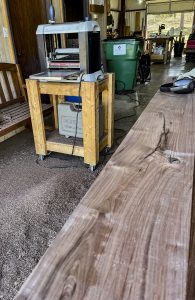The Plain Truth About Planing
At last, all the power tools are tuned up in the woodshop and ready to make some noise. The bandsaw hums along nicely without the blade flying off the wheel. That required painstakingly adjusting the top wheel and aligning other pieces as well. It was trial and error, frequently consulting the owner’s manual. Now it stays on track.
The bandsaw, for me, is the scariest Machine That Can Cut Your Fingers Off in my shop. I am always conscious with any of these machines of where both my hands are, at all times. I would prefer not learning how to type with nine fingers.
The jointer-planer needed new blades. That heavy beast now sits on a mobile base that allows me to roll it around. I use the jointer-planer for smoothing the edge of boards so they can be joined together. All the lumber I use is rough-cut, requiring considerable prep work before I am ready to actually build something. Getting all three blades in the jointer-planer at the proper height took a couple of hours, several YouTube videos showing me how — and frequent breaks when patience began slipping away.
The planer, a different tool, also required new blades, which were pretty simple to replace after a quick review of the manual. All the metal surface of the tools were sprayed with WD-40 and scrubbed with steel wool, to remove the patina of rust that covered them after years of sitting unused.
Now it was time to plane enough black walnut to build a bookcase. I rolled the planer to the edge of the shop’s rolling door, selected about 10 pieces of lumber, set up sawhorses, donned earmuffs, and got to work. The weather was perfect. Both my Beautiful Mystery Companion and our only neighbors were not home. It was just me and Pancho on a sunny Friday afternoon. Planing lumber is loud, dirty work, best performed in isolation. Pancho didn’t seem to mind the noise.
|———|
My stock of lumber is still sizable, bought out of folks’ barns and sheds over the past couple of decades. Black walnut, before it is planed so the surface is smooth, can look like something you might toss on the burn pile or use to build fix a chicken coop whose boards have rotted. Don’t let appearances fool you. The wood is particularly dense, nearly impossible to hammer a nail through. When planed, the purplish grain of black walnut pops out to make for a lovely surface.

I put on the earmuffs and flipped on the switch. The planer hits about 100 decibels as the wood is fed through. A chart I found indicates that 100 decibels is about the same noise level as a jet taking off from a runway. That’s why I plane lumber when nobody is around. I had taken off my hearing aids to reduce the sound. Even with the hearing aids out and the earmuffs on, the planer still screamed loudly as I ran the boards through, shaving off about one-sixteenth of an inch at a time.
The floor below the planer quickly filled with shavings to the point it was difficult to walk around the catch the board as it came out the other side of the planer. I stopped, pulled a couple of feeds sacks out of a barrel, and shoveled shavings into the barrel, then started planning again. About two hours later, I was finished. Cleaning up took another 30 minutes after which I dumped the now-full barrel of shavings out by the fence. They will quickly decompose.
I finished cleaning up the shop, blowing the dust out the door. Pancho brayed loudly when he saw me, no doubt anticipating a treat. I obliged, bringing him a pair of granola bars before shutting up the shop.
Now I can get serious about building that bookcase.
Leave a reply
Fields marked with * are required











